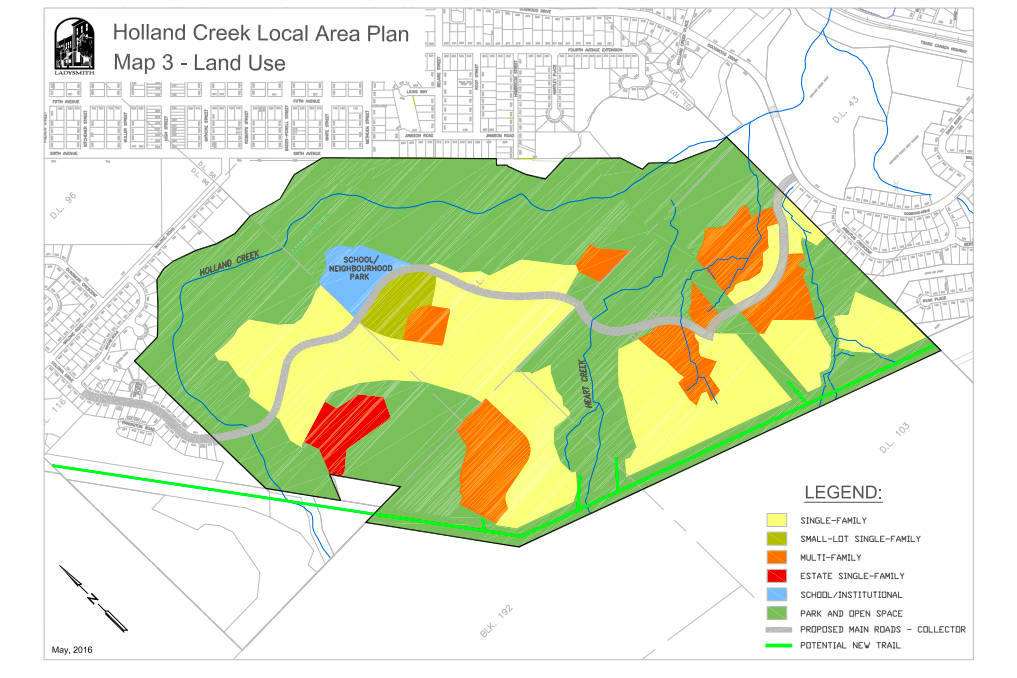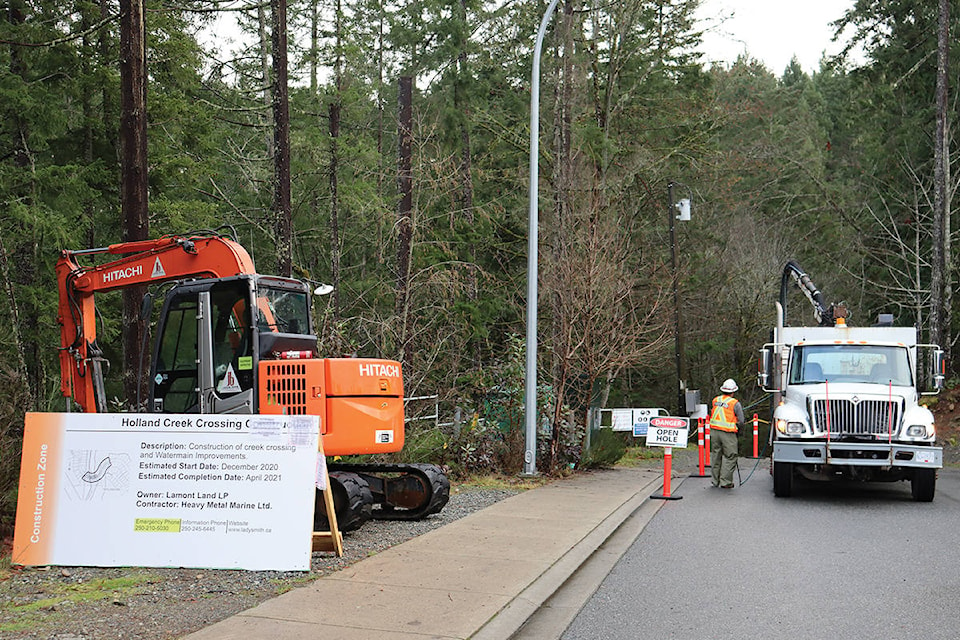Despite protesters who hoped to halt the project, the Holland Creek Crossing is going ahead.
The crossing, which was registered in 2003, will be constructed at the end of Colonia Drive. The proposed design for the crossing is a two-lane road with a multi use pathway on one side for pedestrians and cyclists. Two pedestrian tunnels will pass underneath the roadway and connect with the existing trail system. A development permit application for the crossing was approved in 2018.
RELATED: Ladysmith council approves permit for Holland Creek bridge
A previous town council requested that the design include crossings on both sides of the creek to facilitate at-grade crossings on the road for pedestrians who do not want to use the tunnels. The pedestrian tunnel closest to Colonia Drive will be paved to make it accessible for people with disabilities and mobility challenges.
Bruce Mason, who is involved with the protest group, says he’s been opposed to project since it was first pitched to people of Ladysmith.
“I think it’s a major mistake for the Town to do this,” he said.
Mason sat on the Town’s Parks, Recreation, and Culture Advisory Committee at the time the project was first proposed.
“I expressed horror at the idea at that time. I think this is like most things, until you actually realize it’s going to happen, people don’t respond, or don’t get involved.”
Protesters have expressed concern about the loss of trees, plants, and potential impacts to wildlife in the construction area as well. The habitat of Holland Creek contains mature second growth trees, and is a Grand Fir / Dull Oregon Grape ecosystem.
The Holland Creek Trail is one of Ladysmith’s most prominent trails. Protesters believe that construction of the crossing will jeopardize the tranquility and natural environment of the trail.
“I said this when I was on Parks Rec and Culture, and again in 2018, I don’t think it’s needed immediately. And if they’re going to put something in, put it in where there’s no park,” Mason said. “Don’t put things like this in an area that you’ve established as a park.”
However, when the easement was granted to a previous developer in 2003 for the crossing, the developer provided 9.88 hectares of land to the Town which allowed the Holland Creek trail network to become fully connected on the south side.
The previous project proponent, Bill Eller, sold the project to Lamont Land LP less than a year ago. Lamont Land is a Calgary based land developer. The company has previously completed projects on Vancouver Island, and has been active on the Island since 2005.
Senior Development Manager, Scott Lamont, said that they will use the exact same approvals obtained by Eller — which means that the design of the crossing, and the environmental management plans proposed by Eller will be followed.
Lamont Land LP will be working with Sooke based Corvidae Environmental Consulting. Corvidae completed a Construction Environmental Management Plan and Erosion and Sediment Control Plan for Holland Creek Bridge Construction Report in July 2018, and outlined a 31 point plan to mitigate any potential risks posed by construction of the crossing. Those plans were approved by all necessary regulatory bodies.
The construction will take place in a riparian area. The environment of Holland Creek provides habitat for birds, mammals, amphibians, and invertebrates. The terrestrial ecosystem can provide habitat for black-tailed deer, black bear, and cougar. Many bird species will spend the winter months in the area due to the mild climate. In the aquatic environment chum salmon, coho salmon, pink salmon, rainbow trout, cutthroat trout, and coastal cutthroat trout were all identified.
Although there are rare species of plants and wildlife in the Holland Creek ecosystem, no rare or endangered species were identified in the project area, and there was no evidence of raptor nests, and or heron colonies in the area.
Environmental specialists from Corvidae will be on-site throughout the construction work to ensure environmental regulations are followed.
Once completed, the bridge structure will include a mechanically stabilized earth wall (MSE) that will be vegetated with native plant species including: sword fern, foam flower, salal, false lily-of-the-valley, licorice fern, tomcat clover. The roadside will be planted with 20 big leaf maple trees.
Native plant restoration areas will be fenced for two years to prevent trampling, watered during dry periods until the plants are established to an 80 percent level, and monitored. Invasive species removed by hand, and any native plants that do not survive the establishment period will be replanted.
The permit was issued on the condition that the proponent has provided to the Town of Ladysmith security in the form of an irrevocable letter of credit to guarantee the performance of these conditions. The letter of credit shall be for a period of two years, shall be automatically extended, and shall be in the amount of $12,300.00. There is also a $50,000 landscaping bond.
A half culvert design will allow Holland Creek to flow beneath the bridge. No in-stream work is planned for the construction. Lamont said the bridge footings are above the 200 year flood level for the creek.
“We stay above the water completely. We put in the multi-plate culvert first, then it’s basically back-fill around it. We don’t go into the creek bed at all.”
Lamont said that they will work to minimize the amount of trail closures caused by construction, and suggested that their development could lead to an expansion of the Holland Creek trail network.
“We’re developing something that’s only going to increase the trail area, and maybe open up some areas to the public that aren’t accessible right now,” he said. “We’re really excited for the opportunity that we’ll have with our development, and we look forward to showing the community that we are responsible, and we’re taking everything into consideration.”
RELATED: Phase two of Holland Creek development adds 38 units of housing
The crossing will provide access to Lamont owned lands on the other side of Holland Creek. Those lands are slated for development in the Holland Creek Local Area Plan. Lamont Land is working to finalize designs for the resident component of their development. Those designs will impact the path of the future collector road. The lands within their residential component were previously logged by Eller.

The only road work planned for the area at the moment is for the crossing. Lamont Land has broken up the construction into two phases: the first is constructing the crossing up to the road sub-grade, and the second will include all road work after that.
The overall project cost is estimated to be $2.5 million. The developer also has a $1.025 million bond with the Town to ensure works will be completed.
Protesters have proposed alternatives to the road, including a crossing higher up, or even constructing an auxiliary fire hall on the south end of Ladysmith to accommodate the needs of emergency services. However, none of those proposals have been seen as viable alternatives by town planners or developers.
Protester Nina Rastogi said that she’s disappointed with the Town’s communication efforts around the crossing project, and said there needed to be more done to address the desires of Ladysmith residents.
“There is a lack of teamwork between the citizens and the Town. It doesn’t feel like the Town has done the best they could by the desires of the citizens,” Rastogi said.
Mayor Aaron Stone said that he understands the concerns of residents, and their desire to protect the Holland Creek trail. Ultimately, he said that the crossing is a necessary project from a community design standpoint.
“It’s totally fair to feel that way,” Stone said. “I think if you look at the history of the park, it was established as part of the easement. Decades of community planning, traffic analysis, and growth projects all dictated that Colonia would be the best third access point.”
A local road access point into the Holland Creek area is planned off of Thetis Drive. The other two access points will be on the Dogwood end of the proposed collector road, and the Colonia end.
“It’s important to recognize that these decisions have been made over two decades with a lot of work with the community and people at the time,” Stone said.
Work to construct the Holland Creek crossing began Jan. 6 2021, and is expected to be completed in April. Intermittent closures of the Holland Creek trail near the construction area by Colonia Drive are expected throughout the construction period.
